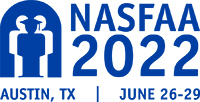A Problem of Fit: How the Complexity of College Pricing Hurts Students - and Universities
By Hugh T. Ferguson, NASFAA Senior Staff Reporter
Moderator:
Rodney Oto, Director of Student Financial Services & Associate Dean of Admissions at Carleton College
Speakers:
Phillip Levine, Professor of Economics at Wellesley College
Miranda McCall, Assistant Vice Provost & Director of Financial Aid at Duke University
Mary Nucciarone, Director of Financial Aid at the University of Notre Dame
Most students pay less than they think, but more than they can afford, to attend college.
Phillip Levine's new book, "A Problem of Fit: How The Complexity of College Pricing Hurts Students — and Universities" provides an in-depth analysis on the economics of the higher education market that lead to these outcomes and includes policy recommendations. In a conversation on Monday, NASFAA members were able to hear from aid directors from Duke University and the University Notre Dame who provided their own perspectives.
In recapping the details of his book, Levine highlighted how he went about documenting the problem of college pricing, detailing why the problem exists, as well as solutions.
On the issue of perceptions of college affordability, Levine detailed ways to measure college costs because for many, the average costs are not the most helpful answers. What makes it less daunting to engage in the financing process of higher education is to provide concrete calculations as to how the costs will impact individuals.
Levine then provided a detailed economic breakdown of college pricing by varying institution types and helped provide context as to why prices are so different across institutions.
In order to best target financial aid for those most in need, Levine used his data to demonstrate that increasing Pell Grants benefits students at lower income levels.
"Doubling the Pell Grant gets the right amount of support to the students who need it," Levine said.
The discussion then delved into how jargon and pricing terms can confound the general public and create perceptions that the added complexity of applying for college makes it seem more expensive and less accessible.
Panelists urged for the higher education system to make pricing less complicated for students and to also work to bolster major early awareness campaigns by providing resources and support for high school counselors and influencers.
The panel then heard directly from NASFAA members who engaged in a Q&A to go over their experiences with the complexity of college pricing and how varying calculations can make the process seem unnecessarily intimidating.
Publication Date: 6/27/2022

You must be logged in to comment on this page.